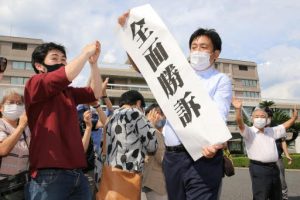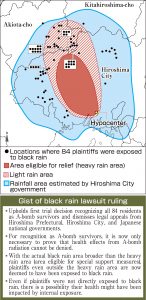Plaintiffs victorious in second trial regarding “black rain” lawsuit
Jul. 15, 2021
by Teru Matsumoto, Staff Writer
Hiroshima High Court upholds first ruling recognizing as A-bomb survivors 84 plaintiffs exposed outside designated rainfall relief area in rejection of government-drawn borders
On July 14, Kazuto Nishii, presiding judge of the Hiroshima High Court in the case, handed down a decision regarding a lawsuit filed by 84 men and women (14 of whom have died) in Hiroshima Prefecture who had sought issuance of Atomic Bomb Survivor’s Certificates. The decision was based on the claim that the plaintiffs’ health was compromised after being exposed to radioactive “black rain” that fell in the aftermath of the atomic bombing despite their location outside the area currently designated by the government as being eligible for support. The high court judge upheld the original ruling made by the Hiroshima District Court recognizing all plaintiffs as A-bomb survivors, dismissing the legal appeals made by the national, prefectural, and city governments and ordering the issuance of survivor’s certificates to the plaintiffs.
Following last July’s original ruling, which represents the first judicial decision on the black rain issue, the court ruled that black rain had fallen in a broader area than the current Japanese government determination of area of eligibility for relief and rejected the validity of government-drawn borders designed to designate the rainfall area. The court also rendered a decision to expand the current framework for recognition of A-bomb survivors, urging the national government to fundamentally review how A-bomb survivors should be certified. After the original ruling was issued, the Japanese government held continued discussions through a deliberative committee for reverification, with consideration paid to possible expansion of the designated area. This most recent ruling is likely to impact the committee’s review work.
Regarding the requirements for granting A-bomb survivor recognition based on the Atomic Bomb Survivors Relief Law, which had become the point at issue in the trial, the judge Mr. Nishii determined it was only necessary to prove that radiation effects on health could not be denied. The judge rejected the national government’s argument that a high degree of evidence based on scientific findings was required for certification.
In addition, by indicating the possibility that black rain had contained radioactive fallout, the ruling emphasized plaintiff health impacts due to internal exposure caused by black rain. It deemed that anyone who had been exposed to black rain should be considered to be an A-bomb survivor, regardless of their development of the 11 diseases, such as cancer and leukemia, that the first ruling had considered to be a requisite for recognition.
With respect to the area on which black rain fell, the court acknowledged that it was broader than the one designated by the government. Judging the circumstances of each of the plaintiffs, it concluded that all were considered to have been exposed to black rain.
The plaintiffs were exposed to black rain on or soon after August 6, 1945, the date of the atomic bombing, and later developed some of the 11 diseases that the government has regarded as a requirement to receive an Atomic Bomb Survivor’s Certificate. The plaintiffs had applied for the certificate to the Hiroshima Prefectural and City governments, but their applications were turned down on the grounds that the sites at which they had been exposed to black rain were located outside the government-designated area eligible for support. They took the case to court in a series of lawsuits during the period 2015–2018.
Issuance of the certificates is based on national policy, but the city and prefectural governments are responsible for administrative operations, such as certification of applicants and issuance of the certificates, in the form of clerical work entrusted by the national government. The national Ministry of Health, Labour and Welfare released a comment indicating, “We are aware that the government’s argument was rejected by the court. We will look into details of the ruling and respond, after engaging in discussions with the relevant government ministries and the Hiroshima Prefectural and City governments.”
Black rain
Rain containing radioactive materials and soot generated by the fires immediately after the atomic bombings is known as “black rain.” Based on a survey conducted by the Hiroshima District Meteorological Observatory in 1945, Japan’s national government concluded that black rain had fallen in an oval-shaped area, about 29 kilometers in length by 15 kilometers in width, and in 1976 it specified an area of about 19 kilometers in length by about 11 kilometers in width as an area designated as eligible for relief measures. Residents who were exposed to black rain in the designated area are entitled to free health examinations. If they are diagnosed as having one or more of the 11 diseases recognized by the national government, such as cancer or cataracts, such individuals are eligible to receive an Atomic Bomb Survivor’s Certificate and access relief measures such as free medical care.
Meanwhile, a number of men and women in Hiroshima City and the town of Akiota-cho in Hiroshima Prefecture—whose applications for the certificate were rejected due to their being exposed to black rain outside the designated area—filed a series of lawsuits in Hiroshima District Court against the Hiroshima Prefectural and City governments during the period November 2015–September 2018 to seek repeal of the certificate rejections. Japan’s national government was a defendant in the lawsuit because it consigned the administrative work of applicant screening and certificate issuance to the Hiroshima City and Prefectural governments.
(Originally published on July 15, 2021)









